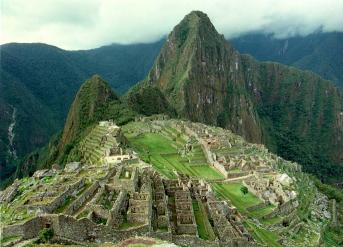| Home |
| Origins of the Quichua |
| The Inca Empire |
| Spanish Colonialism |
| Post-Independence |
| Current Movements |
| Bibliography |
| Ethnic Identities in Latin America |
The Inca Empire

The city of Machu Picchu
|
The Inca Empire
The city of Machu Picchu |
The Inca Empire made
extensive use of the Quichua language. As the official language of
the empire, it served as a valuable unifying factor in an empire with very
little unity of any other kind. Every tribe who had been conquered
or assimilated by the Inca, regardless of tradition of culture, was united
under the same language. In the Inca Empire, Quichua was used for
any trading or administrative task (Peru 14). This helped to make
the rapidly expanding Inca Empire more stable. The Inca allowed a
culture to practice whatever religion or cultural traditions they had traditionally
practiced (Peru 14). Most of the cultures of conquered or assimilated
tribes were relatively similar. They all generally believed in the
power of nature and sacred objects which they called huacas. A huaca
was any object, such as a rock, that a people declared to be sacred (Peru
14).
The Quichua language changed as a result of its contact with
other tribes. There was no written Quichua language, so it was easily
modified (Peru 14). As a result, there are many different customs
and religious practices of indigenous people associated with indigenous
culture. By the time the Spanish arrived the sixteenth century,
the number of Quichua speaking people in South America was approximately
twenty million (Peru 14).
For the Inca, Quichua was an instrument that ensured that their way of life was allowed to thrive for a long period of time in the Andean region. This created a means of unity throughout a divided area. Without the Quichua language, the Inca would not have been able to conduct trade as efficiently or transfer populations, which was vital to the survival and expansion of the Inca Empire (Von Hagen 45).
The arrival of the Spanish presented an obstacle for the survival of Quichua speaking cultures. The Spanish were intent on teaching the indigenous Christianity. They began to suppress indigenous culture and religion. However, the amount of indigenous people who spoke the language made it necessary that the missionaries teach the Bible in both Spanish and Quichua (Peru 15). As a result, the Quichua were able to identify with each other because of their language and differentiated themselves from non-speakers. This helped to create a Quichua identity among the indigenous people. As a result of rapid Inca expansionism and the unity created by having a common language when the Spanish arrived, Quichua survives and is spoken by as much as 47% of Peru today (Von Hagen 45).
Works Consulted
"Peru: The Resilience of Quechuan Culture...And
Tongue," UNESCO Sources No. 104
(9/1998): 14-15.
Von Hagen, Victor Wolfgang. Realm of
the Incas. New York: New American Library,
1961.